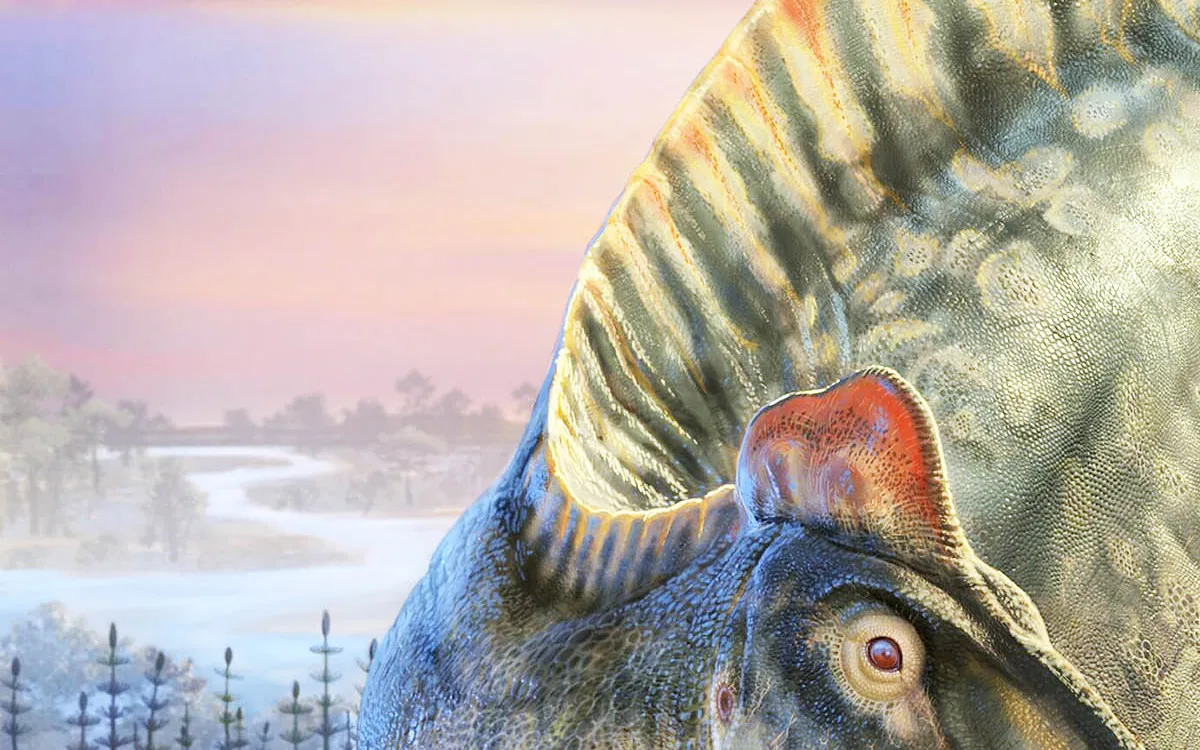
More than 66 million years ago, a duck-billed dinosaur known as Edmontosaurus annectens left behind a significant clue in the form of fossil remains. Scientists from the University of Chicago have recently revisited these fossils in Wyoming, uncovering not just bones, but a stunning clay mask that preserves the dinosaur's skin, spikes, and hooves. This groundbreaking discovery has transformed our understanding of dinosaur “mummies” and their preservation processes.
Duck-billed dinosaurs, scientifically referred to as hadrosaurs, including Edmontosaurus annectens, were among the most prevalent plant-eating dinosaurs during the Late Cretaceous period, approximately 75 to 65 million years ago. Their distinctive wide, flat snouts resembled that of a duck’s bill, which was instrumental in stripping leaves and vegetation from trees and shrubs. Inside their mouths, they possessed hundreds of tightly packed teeth designed to function like a giant grinding machine, ideal for processing tough plant material. Paleontologists regard hadrosaurs as some of the most advanced herbivores of their era due to their highly efficient teeth.
Unlike typical fossilization processes that occur in oxygen-poor lagoons or lakebeds, Edmontosaurus annectens was buried in sandy river channels. Following its death, the carcass dried in the sun before being swept away by a sudden flood. As the body decayed, microbes on its surface formed a thin biofilm that attracted clay minerals from the surrounding sediment. This remarkable process resulted in a submillimeter-thick layer known as a clay template, which captured every wrinkle and scale of the dinosaur’s body before its flesh completely disappeared. Professor Paul Sereno commented, “It’s the first time we’ve had a complete, fleshed-out view of a large dinosaur that we can really feel confident about.”
Using advanced imaging techniques, the research team reconstructed the body of Edmontosaurus annectens with unprecedented detail. A prominent, fleshy crest extended from its neck to its back, transitioning into a series of interlocking spikes along the tail. The skin exhibited intricate polygonal scales, some measuring just a few millimeters wide, indicating a flexible and textured hide rather than a thick armor. The preservation of such fine surface details bolsters the clay templating theory discussed in the journal Science, illustrating how biofilms can replicate soft anatomy even in oxygen-rich environments. “The two specimens complemented each other beautifully,” Sereno noted. “For the first time, we could see the whole profile rather than scattered patches.”
One of the most astonishing findings was revealed beneath the dinosaur’s feet. CT scans uncovered wedge-shaped hooves with flat bottoms encasing the toes of Edmontosaurus. This discovery marks Edmontosaurus as the earliest known hooved reptile and the first land vertebrate exhibiting different foot postures between its front and back limbs. The front limbs had hooves that made contact with the ground, while the hind limbs featured a combination of hooves and fleshy heel pads, facilitating both bipedal and quadrupedal movement. Sereno expressed enthusiasm, stating, “There are so many amazing ‘firsts’ preserved in these duck-billed mummies.”
The researchers identified a four-stage process of natural mummification that led to this extraordinary preservation. Initially, desiccation occurred under dry conditions, followed by a sudden flood that buried the carcass. The body cavities then rapidly filled with sediment while a thin biofilm developed on the surface. Finally, clay minerals adhered to this biofilm, creating a mask that preserved the dinosaur's outer form before the organic tissues dissolved. Within weeks, the skeleton fossilized beneath its clay imprint. This mechanism, termed terrestrial clay-templated preservation, contrasts with traditional fossilization, where mineralization replaces soft tissues. Instead, the clay acts as a natural mold, preserving the outer structure long after the organic matter has vanished.
The Wyoming “mummy zone”, spanning less than ten kilometers, continues to yield an array of fossils, including those of Edmontosaurus, Triceratops, and even Tyrannosaurus rex, all remarkably well preserved. Researchers attribute this phenomenon to the region's rapid geological subsidence and alternating drought-flood cycles near a Cretaceous coastline. These unique conditions have repeatedly facilitated the clay templating process over time. “This may be the single best paper I’ve released,” Sereno declared. “It’s a tour de force that tells a coherent story about how these remarkable fossils come to be and what we can learn from them.”
Through this newfound understanding, the initial puzzle of preserved skin has evolved into a significant breakthrough in the field of paleontology. This research not only illuminates the shapes of long-extinct creatures but also reveals the delicate processes that preserved their final moments in clay. The findings underscore the importance of the study, which has been published in the journal Science.
—– Like what you read? Subscribe to our newsletter for engaging articles, exclusive content, and the latest updates. Check us out on EarthSnap, a free app brought to you by Eric Ralls and Earth.com. —–